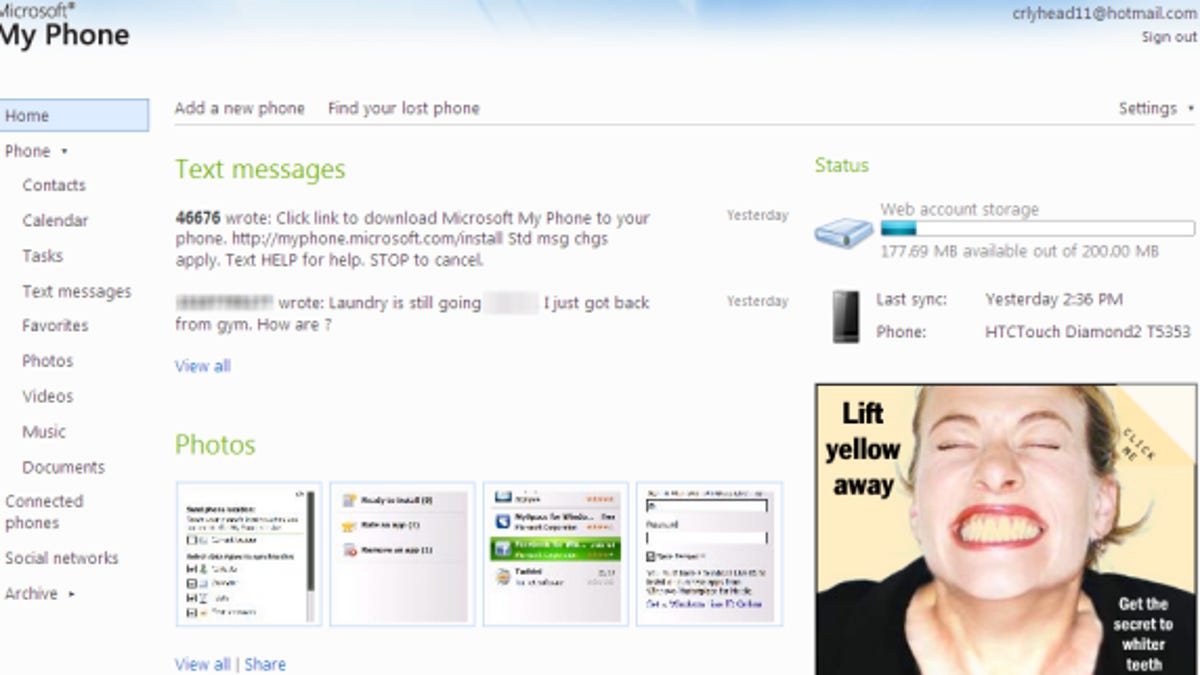With My Phone mobile sync, Microsoft reinvents the wheel
Microsoft's My Phone sync and share service offers much of the same as other online mobile phone managers. But the premium features are especially useful for finding and securing a lost phone.

In step with the release of Windows Mobile 6.5 phones, Microsoft also graduated its My Phone syncing service for Windows phones (6.0-6.5) from beta to a full release. As we reported earlier this morning, most of the new features are premium additions to help you find your phone if it gets lost or stolen. We'll get to these later on. For the most part, the My Phone service acts as we expect it to--as a small app you download onto your phone, with the bulk of the management taking place on your dashboard online.
Sure enough, after downloading My Phone and signing in with your Windows Live ID (or signing up for a new one), you'll pick from a list of data types you want to sync. These include contacts, calendar items, notes, tasks, memos, photos, and videos, songs and text messages, and documents.
Syncing took over a half hour the first time around, but we were on a terribly weak EDGE connection. Let that be a lesson to all. In the style of our times, the online dashboard resembles an e-mail in-box. From it, you can view the contents of your phone, and to some extent manage certain aspects. for instance, you can add a new calendar item and comfortably edit contact info from the desktop keyboard, but we haven't found a way to add a contact or create a new text message. You can upload songs from any desktop to remotely load onto your phone, but My Phone missed the smattering of songs we already had on the phone. The photo sharing feature is more fleshed out, with options to publish images to Windows Live, Facebook, Flickr, and MySpace.
We're bummed that Microsoft hasn't broadened the syncing and sharing capabilities since My Phone's beta days. With so many other start-ups creating fuller featured in-boxes and management dashboards than My Phone, it seems to us that Microsoft has unnecessarily reinvented the wheel.
Wheels are good things, but we would have much preferred to see Microsoft strike a deal with a partner like Dashwire, which made a similar, much more customizable dashboard you could use to originate texts and share a variety of media over e-mail. Dashwire is in the process of offering a similar product branded for Best Buy Mobile's mIQ syncing service. The legacy Dashwire dashboard had a stylish look that could have helped increase Windows phones' cool factor (My Phone is typically aesthetically bland), and best yet, Dashwire headquarters are practically around the corner from Redmond's mother ship.
Despite failing to wow us with syncing and sharing features, My Phone's premium add-ons are what differentiate its package. If you lose your phone, you can force it ring loudly for 60 seconds (they mean it), even if set to silent or vibrate, just so long as it's on. You can choose to map its current whereabouts, based on GPS or cell tower triangulation. A free variant on this maps the last known location your phone was in, which may not be the same as where it was when it disappeared. In addition, you can lock your phone remotely, also sending a message to the screen, maybe offering a reward for the finder, or sending a contact number. You'll need a pin to unlock it when the phone is recovered. Lastly, there's remote erasure, the most extreme measure.
My Phone costs about $5 for seven days of access to the entire package. You purchase it as needed from the My Phone site, from within the "Connected Phones" navigation. Microsoft is letting users try the premium find-my-phone features for free until November 30, 2009. Note that you'll see a message that you can try it out for 7-day increments.
While we haven't been overly impressed with My Phone's limited syncing and sharing features, the affordable phone-finding and securing tools do offer peace of mind--and maybe even a recovered phone.

